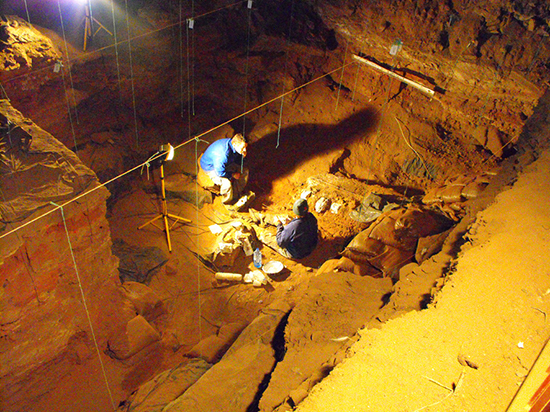Latest News Archive
Please select Category, Year, and then Month to display items
05 June 2018
Photo Supplied
 Archaeological excavations in the Wonderwerk Cave, north of Kuruman in the Northern Cape.
Archaeological excavations in the Wonderwerk Cave, north of Kuruman in the Northern Cape.
Research fellow Dr Lloyd Rossouw from the Department of Plant Sciences at the University of the Free State (UFS) recently published an article in the Nature Ecology and Evolution journal with Dr Michaela Ecker from the University of Toronto as lead author, and Dr James Brink, research fellow at the UFS Centre for Environmental Management. The findings described in “The palaeoecological context of the Oldowan-Acheulean in southern Africa” provides the first extensive paleoenvironmental sequence for the interior of southern Africa by applying a combination of methods for environmental reconstruction at Wonderwerk Cave, which have yielded multiple evidence of early human occupation dating back almost two million years ago.
Where water once was
The Wonderwerk Cave is found north of the Kuruman hills (situated in Northern Cape) a 140m long tube with a low ceiling. The surroundings are harsh. Semi-arid conditions allow for the survival of only hardy bushes, trees, and grasses. But during the Early Pleistocene, stepping out of the Wonderwerk Cave you would have been greeted by a completely different site, the researchers found. Using carbon and oxygen stable isotope analysis on the teeth of herbivores (Dr Ecker), fossil faunal abundance (Dr Brink), as well as the analysis of microscopic plant silica remains (phytoliths) excavated from fossil soils inside the cave (Dr Rossouw), the results show that ancient environments in the central interior of southern Africa were significantly wetter and housed a plant community unlike any other in the modern African savanna.
What difference does it make?
While East African research shows increasing aridity and the spread of summer-rainfall grasslands more than a million years ago, the results from this study indicate an interesting twist. During the same period, shifts in rainfall seasonality allowed for alternating summer and winter-rainfall grass occurrences coupled with prolonged wetlands, that remained major components of Early Pleistocene (more or less the period between one and two million years ago) environments in the central interior of southern Africa. That means our human ancestors were also living and evolving in environments other than the generally accepted open, arid grassland model.
Golden strains: Hansgeorg Schmeiser (flute) and Albie van Schalkwyk (piano)
2008-04-15

Hansgeorg Schmeiser – an Austrian flautist and Albie van Schalkwyk – a lecturer in piano at the UFS, captivated concert-goers on Thursday evening with a virtuoso performance. This was the second time that Hansgeorg has given a performance in Bloemfontein accompanied by Albie. Despite the Easter weekend and the holiday period, the concert was well supported by the public.
With his solid gold Muramatsu flute and a celebrated pianist before the keys plus a varied programme, the two artists had the audience poised on the edge of their seats – beginning with the Sonata in G minor by J.S. Bach and followed by Franz Schubert's Theme and Variations on Trock'ne Blumen for flute and piano. After the interval they performed the Sonata for flute and piano by Martinù – a composition that is seen as one of the most important 20th century works in the flute repertoire. Schmeiser's performance of the solo piece for flute by the Japanese composer Fukushima where modern playing techniques require the achievement on various tone colours and fluctuation intensity was especially impressive.
The demanding programme was concluded with the Hungarian Fantasy for flute and piano by Albert Franz Doppler. It was no surprise that the audience demanded the two back onto the stage for an encore for which they played the second movement (Siciliano) of J.S. Bach's Flute Sonant No. 2 in E minor.